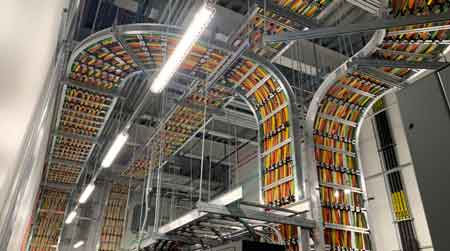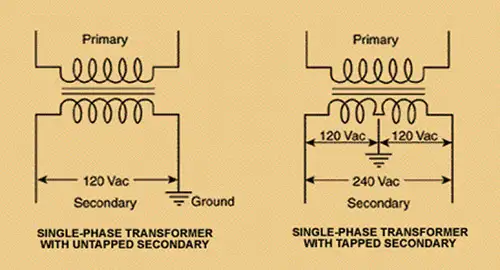Cable Tray Explained

Download Our OSHA 3875 Fact Sheet – Electrical PPE for Power Industry Workers

- Follow rules for rubber gloves, arc-rated PPE, and inspection procedures
- Learn employer obligations for testing, certification, and training
- Protect workers from arc flash and electrical shock injuries
Cable tray systems enable organized cable management and power distribution, supporting ladder and perforated trays, wire mesh raceways, grounding, NEC compliance, load ratings, and spans in industrial facilities, commercial buildings, and data centers.
What Is a Cable Tray?
A cable tray is a structural support that routes and protects power and data cables for safe, compliant installation.
✅ Types: ladder, perforated, wire mesh, solid-bottom, trough
✅ Design: load class, span, support spacing, corrosion protection
✅ Compliance: NEC 392, grounding/bonding, firestops, cable fill
A cable tray is an essential component of modern electrical systems, designed to support and organize electrical cables effectively. It provides a structured approach to cable management, ensuring that wiring is neatly arranged, easy to access, and well-protected from external damage. The importance of using a high-quality tray cannot be overstated, as it helps reduce clutter, enhances safety, and allows for future scalability in electrical installations. Easy to install and maintain, trays offer a reliable solution for routing cables in industrial, commercial, and utility environments. Understanding the various types, materials, and maintenance requirements is crucial for ensuring long-term performance and efficiency in cable management systems.
Before specifying a tray system, it helps to review the fundamentals of conductor types and insulation, and the overview of electrical cable classifications clarifies how cable construction influences pathway design.
Types of Cable Tray
Different types of cable trays are available to accommodate various cable types and installation requirements:
- Trough Trays: These are the most common type, consisting of a U-shaped channel that can be open or covered.
- Ladder Trays: Ladder trays feature rungs that support cables from below, allowing for easy cable installation and removal.
- Wire Mesh Trays: These trays provide ventilation and heat dissipation for cables, making them suitable for high-density installations.
- Gutter Trays: Gutter trays are designed to support cables along walls or ceilings, often used for smaller cable bundles.
Where a cable run must transition to outdoor spans or utility interfaces, aerial cable best practices can inform selection of hardware and tension controls beyond the tray.
Test Your Knowledge About Wiring Devices!
Think you know Wiring Devices? Take our quick, interactive quiz and test your knowledge in minutes.
- Instantly see your results and score
- Identify strengths and areas for improvement
- Challenge yourself on real-world electrical topics
What are the installation guidelines for cable trays in electrical systems?
Proper installation is crucial for the effectiveness of a cable tray system. They should be installed with sufficient spacing between support points to ensure they can handle the cable load without sagging. It is also important to ensure that trays are grounded correctly to prevent electrical faults. Cables must be secured within the tray, avoiding excessive tension or bending that could damage the wiring. Additionally, trays should be easy to access for future maintenance, making them a practical solution for long-term cable management. For step-by-step practices, the installation of cable in cable trays guide outlines spacing, loading, and routing criteria.
Effective bonding and earthing of metallic trays should align with the facility's ground grid design principles to maintain low-impedance fault current paths.
To control mechanical forces during fault conditions and vertical drops, appropriate cable cleats and spacing methodologies ensure secure containment within the tray system.
What materials are commonly used for cable trays, and how do you select the right one?
Cable trays are typically made from materials such as steel, aluminum, and fiberglass. Steel is known for its durability and strength, making it suitable for heavy-duty installations. Aluminum offers a lightweight, corrosion-resistant option, ideal for environments prone to moisture. Fiberglass trays provide excellent resistance to corrosive chemicals and extreme temperatures, making them ideal for harsh industrial conditions. When selecting the right material, it is important to consider the installation environment, load requirements, and the type of cables being supported. High-quality materials ensure that the tray will perform effectively for years to come. When coordinating with underground feeders, insights from copper underground transmission practices can guide corrosion mitigation and separation from tray-borne circuits.
How do you maintain and inspect a cable tray to ensure long-term performance?
Regular maintenance and inspection are key to ensuring the long-term performance of a system. Periodic checks should be conducted to ensure that cables are properly secured and that no damage has occurred to the tray or wiring. Cleaning the tray to remove dust, debris, and other contaminants will help maintain the integrity of the system. Additionally, any signs of corrosion or wear should be addressed immediately to prevent further deterioration. High-quality trays that are easy to install and maintain will ensure reliable cable management and reduce the need for costly repairs. In rigorous operating environments, the cable handling and testing procedures help standardize inspections and post-install checks.
A cable tray is an essential part of any well-organized electrical system. By providing structured cable management, ensuring safety, and offering scalability for future expansions, these trays are a valuable investment. Selecting the right type and material, following installation guidelines, and performing regular maintenance will ensure the system’s effectiveness for years to come.








